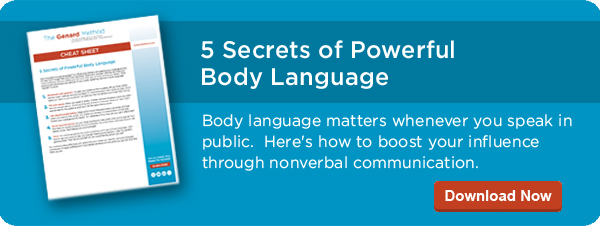Remember Bill Clinton?
Whether you favor Che Guevara T-shirts or quote William F. Buckley at cocktail parties, you’ll probably agree with me that William Jefferson Clinton was and is a charismatic public speaker.
What made President Clinton so good at the lectern? Certainly, he was smooth. And he displayed an extraordinary sense of ease, coupled with firm control. Not many speakers, after all, could deliver a nationally televised address from memory while a TelePrompTer relentlessly rolled out the wrong speech!
Perhaps Clinton’s chief attribute as a speaker, however, was the pure enjoyment he displayed speaking to audiences.
President Clinton's Public Speaking Secret
Wait a moment, though . . . How exactly do we know that about President Clinton? How is it possible that we can assess Clinton’s feelings about speaking in public since we’re not mind-readers?
Well, it was obvious visually. The body language; the easy stance and gestures; the frequent smiles; and the sheer joy of performing. All these things declared that this was a man who lived for these moments in his professional life.
Bill Clinton, then, is an excellent example of an important phenomenon in public speaking, one that most speakers aren’t aware of. You yourself are always your best visual aid.
Audiences Think and Respond Visually
Visual input obviously has a huge impact on how audiences receive your messages. (One famous study said it's as high as 55%.) You’re probably already focused, for instance, on the charts, graphs, PowerPoint, and handouts you use as visual tools.
But your most important visual persuader isn’t any of these devices. It’s you.
Think about it for a moment: You are the one visual component of your speech that’s always on stage front and center. You're the visual that doesn’t just sit there, but walks and talks and argues convincingly! You're the visual that shares the beliefs of audience members and speaks to them from common ground. You’re also the only visual that can adapt as need be, thinking on your feet and changing your presentation in response to audience input.
Those are all undeniably powerful aspects of public speaking.
Maximizing Your Power to Persuade
So don’t relinquish your power as a visual persuader to your “visual aids.” Your audience has seen endless charts and PowerPoint slides and workbooks. But they have either never seen you, or they haven’t seen you talking about this topic today.
Spend the time you think is necessary to put together the visual components of your presentation. These elements can and should be compelling forms of evidence. Learn the techniques of working with these visual aids, and practice going through your PowerPoint presentation.
But before you do all that, give some serious thought to how you’ll look and move in front of your audience. In the well known phrase: your body language. The visual element of your speech that you contribute to your argument is a hugely important persuader. Find ways to make it work to your advantage, in persuasive speaking and every other kind.



